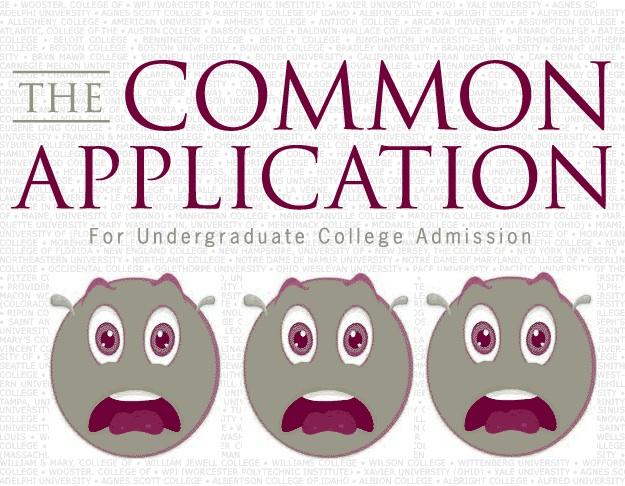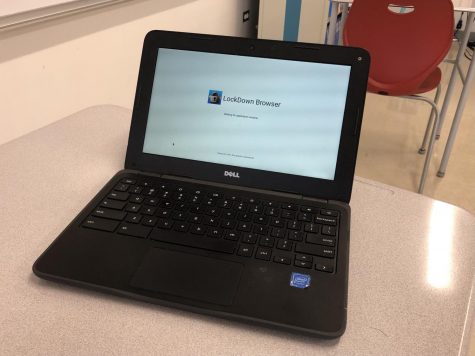A not-so-common app
One size doesn’t fit all with the Common App.
STUDENT STRESS: Designed for universality, the Common App actually creates stressful limitations on students and their applications.
As many of us are painfully aware, the college process today is more difficult and extreme than in any previous generation. According to CBS, in 2001 the average college acceptance rate was 71 percent. Only 10 years later, the average acceptance rate is over five percent lower at 65.5 percent. Colleges seem to ask for everything. You need to have a well-balanced academic schedule, even if you’re only passionate about one subject. You need to be either well-rounded in your activities, a regular Renaissance man dabbling in everything, or, conversely, “pointy” in your activities, focusing only on the one or two things you are truly passionate about but exploring them deeply. You need to write essays (sometimes upwards of four or five per school) and establish relationships with adults who can rave about you in recommendation letters. And after all this, there’s a pretty good chance you won’t even get into the school of your dreams.
The college process is focused on standing out and being unique, on displaying why you would both fit into the college community and also excel in that community. It’s all about shining as an individual star: the spotlight is on you and it’s finally your time to sing. So why do we all have to use the same application?
The Common Application (or Common App, for short) was first created in 1975. The idea was to streamline the college process so that applicants didn’t have to retype personal information for every college. In 2014, it has become an institution of the US college process.
Last year alone, 813, 069 applicants applied using the Common App, submitting a total of 3.45 million applications. That’s about four applications per student. This seems reasonable until you realize that the Common App only has 517 member colleges (including international institutions) while the National Center for Education Statistics reports the existence of 7,021 postsecondary US institutions. Which means students are applying to many schools outside of the Common App as well.
I want to focus on the Common App and the fundamental problems it raises. Simply put, when it comes to college applications, one size doesn’t fit all. People by nature are different, and when it comes to expressing your entire life on a few sheets of paper, these differences become more important than ever. Without the freedom to express them, students can easily submit drab, overly standardized applications.
I recognize the beauty of the Common App: it means students don’t have to apply separately to as many schools as they once did. It means admissions officers can better compare one student’s application to another’s. They were given the same restrictions and space, as well as the same time frame to complete the application. But the Common App itself is not the best way to express the essence of a student’s work and personality. It’s hard enough to dilute yourself down to a 650 word essay and some test scores. Common App restrictions make it harder.
So what should Common App do to solve the problems? I think there are three major areas of concern that should be addressed as soon as possible.
Make the Common App more intuitive.
The Common App is currently organized in a series of tabs. There’s a tab for the Common App itself, and one for the “Dashboard,” which organizes your chosen colleges. But the organization of these tabs is not intuitive. Here are some suggestions:
Instead of only being able to access recommenders under the “My Colleges” tab, create a section within the “Common App” tab. I know that seems like a small annoyance, but if you’ve spent a significant amount of time trying to find things on the Common App website, you probably know what I mean. It shouldn’t take two hours to figure out how to type your recommenders’ emails into the system while making sure they don’t get the email yet because you want to talk to them first. This is just one example of the many little things that make the Common App frustrating, and they’re pretty easy to fix. Also, allow applicants to view a “print preview” of their application (what it will look like to the college admissions counselors) before they fill out the entire application.
Get rid of pesky character and word limits in the activities section.
In fact, get rid of limits in all sections (except for the essay, see next paragraph). The 50 character limit on the position/leadership description and organization name box is ridiculous—I have a friend who can’t fit the name of the charity she works for in 50 characters, not to mention her position or leadership title. It’s also nearly impossible to show that you’ve had different positions in the same club over a number of years because there isn’t enough space. I understand the desire to be concise, but at this extreme level it is counter-productive. Giving applicants as much space as they need to explain their title and the activity itself (you only get 150 characters for details, honors won and accomplishments) allows them to spend more time editing their essays and less time obsessing over how to record the ten honors they’ve won (for, say, Deerprints newspaper articles). Good writers will recognize the need to be concise, and this will be reflected in their application. The current system penalizes anyone who has participated in activities that are a little “outside of the box” because they don’t have room to explain them.
In general, the annoying number limitations on the Common App should be eliminated. Only allowing students to include ten activities and current-year classes is a mistake—I know of a DHS senior who is taking many one-semester courses this year and actually has over ten classes, but he can’t include them all. And some of the limitations are just absurd: if you have over five siblings, you’re out of luck. The Common App will only let you record your favorites.
Bring back the open essay.
One of the Common App essay prompts used to be open ended: write about whatever you want to write about. This gave students, particularly those who consider themselves writers, the chance to tell whatever story they would like, unencumbered by a prompt. The current Common App doesn’t allow for this. Granted, the prompts are fairly open-ended. One asks about a failure you’ve overcome, another about a place where you are perfectly content. And it’s not that important to specifically answer the question, because the Common App essay is just a chance for you to reveal more about yourself, independent of whatever schools you are applying to. Colleges don’t care whether you’re talking about a belief you’ve challenged or an event that transitioned you to adulthood as long as you talk about yourself. But it’s still hard to justify wasting 150 or more words (when you only have 650) to try to connect your true story to one of the prompts.
All of these suggestions are just a start, of course. Institutionally, the college process will change rapidly in the next few decades due to online classes and degrees. The application process will probably change with it. But until then, students applying to college with still have to make do with the impractical, limiting Common App. And the least they can do is take a little bit of the stress and pressure off of students by fixing the major problems with the application.











